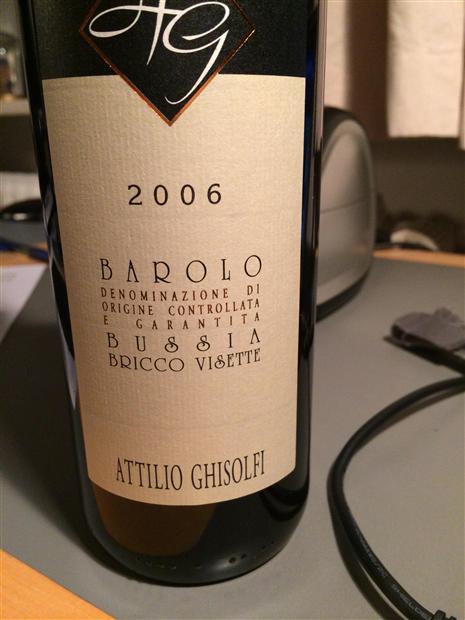
External search
Google (images)
Wine Advocate
Wine Spectator
Burghound
Wine-Searcher
Vintages
2019
2018
2017
2016
2015
2013
2012
2011
2010
2009
2008
2007
2006
2005
2000
1999
1992
N.V.
From this producer
Show all wines
All tasting notes
|
| Drinking Windows and Values |
| Drinking window: Drink between 2008 and 2020 (based on 33 user opinions) |
| Community Tasting History |
| Attilio Ghisolfi Producer websiteAttilio Ghisolfi Barolo Bussia Bricco VisetteThe Visette cru is located within the Bussia area of the villane of Manforte d’Alba, one of the most renowned for the growning of Barolo wines with inique elegance, structure and long life. Gianmarco – the we maker who is currently in charge of the company – is more convinced than ever that the quality of a wine is obtained in the vineyard, so special attention is paid to equilibrium by monitoring the vigour and productivity of the vines. The wine-making process, performed using modern techniques, is designed to produce classic, high quality wines featuring good balance and easy to drink. Aged partly in small barels and partly in large oak casks, after blending the wine is further matured in the bottle for six months prior to being released.
Technical Details
Producer: Attilio Ghisolfi
Country: Italy
Region: Piedmont
Grape Variety: 100% Nebbiolo
Residual Sugar: 1.1 g/l
Total Acidity: 5.76 g/l
Winemaker Notes
The grapes for this wine come from south and southwest-facing vineyards that are between 5 and 15 years old. The vineyards sit at about 985 to 1150 feet in marly, white tufa terroir in the Visette (Bussia) area, near the village of Monforte d’Alba. Masceration on skins takes place over ten days at controlled temperatures, with natural fermentation taking place using native yeasts. The resulting wine is matured in French oak barriques for 30 months, with a further six months’ ageing in bottle prior to release.
Tasting Notes
The color is a ruby red, almost garnet, with a flowery, rich and expansive nose. The palate is well-balanced, mature, deep and nicely tannic, with a long and lingering finish.
Serving Notes
Attilio Ghisolfi Barolo Bussia is a perfect accompaniment to roasts and game, truffle-flavored dishes and mature cheeses.NebbioloNebbiolo is a red grape indigenous to the Piedmont region of Italy in the Northwest. The grape can also be found in other parts of the world, though they are not as respected.
Nebbiolo is often considered the "king of red wines," as it is the grape of the famed wines of Barolo DOCG, Barbaresco DOCG, and Roero DOCG. It is known for high tannins and acidity, but with a distinct finesse. When grown on clay, Nebbiolo can be very powerful, tannic, and require long aging periods to reach its full potential. When grown on sand, the grape exhibits a more approachable body with more elegant fruit and less tannins, but still has high aging potential.
"Nebbiolo" is named for the Italian word, "nebbia", which means "fog", in Italian and rightfully so since there is generally a lot of fog in the foothills of Piedmont during harvest.
Nebbiolo is a late-ripening variety that does best in a continental climate that boasts moderate summers and long autumns. In Piedmont, Nebbiolo is normally harvested in October.
More links:
Varietal character (Appellation America) | Nebbiolo on CellarTrackerItaly Italian Wines (ItalianMade.com, The Italian Trade Commission) | Italian Wine Guide on the WineDoctorPiedmont Vignaioli Piemontesi (Italian only)
On weinlagen-infoLanghe Consorzio di Tutela Barolo Barbaresco Alba Langhe e Roero | Union of Producers of Albese Wines (Albeisa)BaroloRegional History:
The wines of Piedmont are noted as far back as Pliny's Natural History. Due to geographic and political isolation, Piedmont was without a natural port for most of its history, which made exportation treacherous and expensive. This left the Piedmontese with little incentive to expand production. Sixteenth-century records show a mere 14% of the Bassa Langa under vine -- most of that low-lying and farmed polyculturally. In the nineteenth century the Marchesa Falletti, a frenchwoman by birth, brought eonologist Louis Oudart from Champagne to create the first dry wines in Piemonte. Along with work in experimental vineyards at Castello Grinzane conducted by Camilo Cavour -- later Conte di Cavour, leader of the Risorgimento and first Prime Minister of Italy -- this was the birth of modern wine in the Piedmont. At the heart of the region and her reputation are Alba and the Langhe Hills. This series of weathered outcroppings south of the Tanaro River is of maritime origin and composed mainly of limestone, sand and clay, known as terra bianca. In these soils -located mainly around the towns of Barolo and Barbaresco -- the ancient allobrogica, now Nebbiolo, achieves its renowned fineness and power.
map of Barolo DOCG
An interesting thread on Traditional vs. Modern Barolo producers:
https://www.wineberserkers.com/forum/viewtopic.php?f=1&t=106291 |
|




